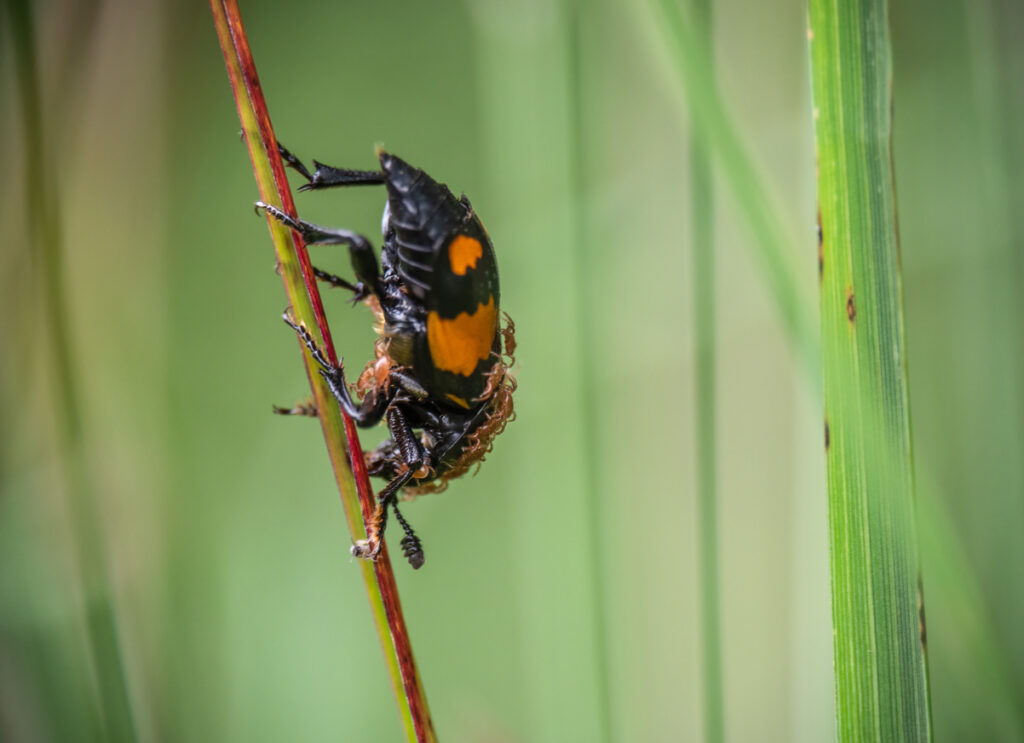
They’re not pretty. They live in death. And yet carrion beetles—those odd little insects that thrive on rotting meat—are becoming unlikely stars in the fight against antibiotic resistance. While most of us look away from anything dead or decaying, scientists are starting to lean in, discovering that these beetles may hold the key to powerful, targeted antimicrobial compounds the medical world desperately needs.
1. They survive in places humans never could.
Carrion beetles spend their lives crawling over decomposing animals teeming with bacteria, including strains that cause serious infections in humans. And yet, they rarely get sick. That fact alone makes them fascinating to researchers looking for new ways to fight drug-resistant pathogens.
If these beetles can thrive in bacterial war zones, they must have built-in protections. Understanding how they do it could unlock defences we can’t yet replicate in the lab—or even imagine.
2. They coat their meals in natural antibiotics.
Before laying eggs, some carrion beetles carefully bury carcasses and coat them in a special secretion. This goo doesn’t just preserve the meat—it actively fights off harmful microbes. It’s their way of preparing a clean nursery for their larvae. Scientists are now isolating these secretions to identify the exact compounds involved. Early results suggest they include antimicrobial substances unlike anything currently on the market.
3. Their microbiome is part of the defence system.
Beetles don’t fight alone—they bring allies. Like us, they carry gut bacteria that help them digest and protect. Some of these microbes may produce antibiotics to defend their host, adding a second layer of protection against infection. This opens the door to discovering new bacteria-based treatments. It’s possible that the antibiotics of the future will come not from beetles themselves—but from the microscopic hitchhikers that live inside them.
4. Their antimicrobial tactics are highly targeted.
Unlike the broad-spectrum antibiotics we use in medicine—which often kill off helpful bacteria alongside harmful ones—some of the compounds found in beetle secretions seem to be much more selective. That kind of precision could be a game changer. Treatments that leave healthy bacteria intact while attacking specific threats are exactly what we need to fight resistance and protect long-term health.

5. Their parenting behaviour shapes microbial environments.
Carrion beetles don’t just dump eggs and walk off. They actively care for their young, preparing food, defending the carcass, and keeping microbial threats at bay through secretions and cleaning behaviour. That parenting effort doubles as microbial management. The way they curate the environment for their offspring may teach us how to approach infection control and microbial balance in hospitals, too.
6. Their world is the perfect pressure test for antibiotics.
Think about it: if a compound can hold its own in the bacteria-filled chaos of a decomposing carcass, there’s a good chance it can do serious damage to pathogens in a hospital setting too. Beetles have been refining these chemical defences for millions of years, with constant microbial pressure pushing their biology to adapt. That’s exactly the kind of stress-testing modern antibiotics need—but often don’t get in a lab.
7. They offer new chemical structures we haven’t used yet.
One of the main reasons antibiotic resistance is spreading so fast is because we keep repackaging the same basic drug structures. However, beetles use totally different chemistry to survive—meaning the compounds in their secretions could bypass existing resistance altogether. That novelty is crucial. It’s not just about having more antibiotics—it’s about having different ones that attack bacteria in ways they haven’t seen before.
8. Their strategies may teach us how to delay resistance.
Carrion beetles live in constant contact with bacteria, yet their antimicrobial tools seem to remain effective. That’s rare. It means they may not just be producing antibiotics—they’re using them in a way that doesn’t immediately cause resistance. If we can understand how they achieve that balance, we might finally develop smarter usage strategies that prolong the life of the antibiotics we do create.

9. They’re giving researchers new places to look.
Until recently, most antibiotic research focused on soil bacteria or fungi. Carrion beetles weren’t even on the radar. But as superbugs become more common, scientists are now digging deeper into ecosystems we used to ignore—or avoid entirely. The beetles are proof that untapped solutions often live in places we’ve overlooked. And in the face of a global antibiotic crisis, curiosity might just be our most powerful tool.
10. They remind us that nature is still ahead of us.
For all our lab coats and microscopes, carrion beetles have been managing bacterial threats without medical training for millennia. Their biology doesn’t just offer us tools—it reminds us that nature has already solved problems we’re still struggling with. Sometimes, innovation starts by watching what the beetles are doing, and being brave enough to learn from it, even when it’s buried in rot and slime.